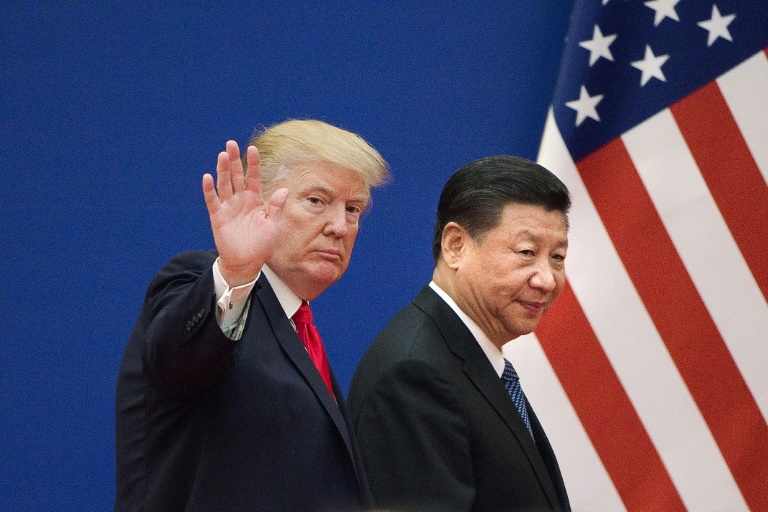The United States and China announced a major thaw in their trade war Friday, including immediate cuts to punishing import tariffs, but a lack of detail left markets cautious.
“We have agreed to a very large Phase One Deal with China,” President Donald Trump tweeted after officials in Beijing made a similar announcement.
The news could be a boon to Trump, who has made trade wars a keystone of his foreign policy, just as a congressional committee set up a full vote on his impeachment next week for alleged abuse of office.
After multiple false dawns in the tussle between the world’s top two economies, which Trump launched in March 2018, investors were at least relieved that he canceled a new round of tariffs due to kick in on Sunday.
Those levies, which would have hit consumer electronics like cell phones and computers, “will not be charged because of the fact that we made the deal,” Trump tweeted.
In a major concession, Washington will slash in half the 15 percent tariffs imposed on $120 billion in Chinese goods, like clothing, that were imposed September 1 and had a bigger impact on American shoppers than previous rounds.
But Trump said existing tariffs of 25 percent on $250 billion of Chinese imports would stay in place pending further negotiations on a second phase deal.
There was little detail on what the United States will get in return for the tariff concession, though officials touted “meaningful, fully enforceable structural changes” from China on issues like protections for American technology.
And Trump said phase two talks, seeking a much broader reset of the trade superpowers’ relations, could start “immediately.”
– Reprieve for US farmers –
American farmers who bore the brunt of the trade war and retaliation by Beijing which slashed exports, could get a reprieve in the deal.
Trump said Beijing had already “agreed to many structural changes and massive purchases of Agricultural Product, Energy, and Manufactured Goods, plus much more.”
 AFP / Gal ROMAUS top trade partners
AFP / Gal ROMAUS top trade partners“I think in agriculture they will hit $50 billion,” and take effect “pretty soon,” he told reporters at the White House.
China’s Vice Finance Minister Liao Min told reporters that Beijing would also call off retaliatory tariffs planned to respond to Sunday’s now scrapped US measures.
Vice Commerce Minister Wang Shouwen said the initial agreement includes strengthening protection of intellectual property rights, expanding market access and safeguarding rights of foreign companies — issues at the heart of US complaints.
No date has been set for signing the deal, which must be translated and go through a legal review, Wang said.
“It is hoped that both sides will abide by the agreement, work hard to implement the relevant contents of the first phase of the agreement.”
Read Also: Greenpeace Chief Locked Out Of UN Climate Meet Amid Protest
– Skepticism is high –
Though investors were relieved that no new tariffs would be implemented, US stock markets actually fell on the news.
Trade economist Mary Lovely said the deal could only be viewed as a “partial win” which “didn’t move the needle very much.”
 AFP/File / STRShippers at the foreign trade container terminal in Qingdao will be looking out for a resolution to the US-China tariffs war
AFP/File / STRShippers at the foreign trade container terminal in Qingdao will be looking out for a resolution to the US-China tariffs warAnd the gains do not compensate for the damage to US farmers and businesses, she told reporters.
“President Trump is desperately trying to get back to where the economy was 18 months ago,” before taking this “unilateral, brute force approach,” Lovely said.
In a sign that tensions remain high, Foreign Minister Wang Yi said earlier Washington was “suppressing” China in a number of fields, including the economy, trade and technology and had “seriously damaged the foundation of hard-earned trust between China and the US.”
Washington has also angered Beijing by backing Hong Kong’s pro-democracy movement and criticizing China’s mass detention of mostly Muslim minorities in the northwest region of Xinjiang.
– Reduced ambitions –
With his 2020 re-election battle heating up, Trump is keen to seize the political initiative and show voters his punishing struggle with China has brought results.
The US ultimately wants China to open its vast economy to more goods and to conduct sweeping reforms of what Washington has long called systemic abuse against foreign investors.
But the White House has gradually shifted its position to make it clear that the interim “phase one” deal is all it can achieve for now. The difficult issue of massive industrial subsidies was left to phase two.
Trump himself has blown hot and cold, repeatedly insisting that China needs a deal more than the United States does.
At the end of November, he said he was in the “final throes” of negotiations, but days later he spooked world financial markets when he said “I have no deadline” for a resolution.
